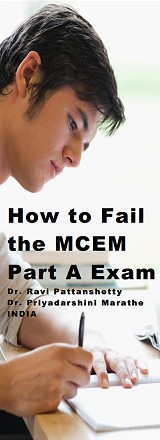EmergencyMedicine.in
EMinside
Favorites
Recommended
ATLS India - Advanced Trauma Life Support
 atls.in
atls.in 
American College of Emergency Physicians
 acep.org
acep.org
College of Emergency Medicine, United Kingdom
 rcem.ac.uk
rcem.ac.uk
Australasian College of Emergency Emergency Medicine
 acem.org.au
acem.org.au
 atls.in
atls.in 
American College of Emergency Physicians
 acep.org
acep.orgCollege of Emergency Medicine, United Kingdom
 rcem.ac.uk
rcem.ac.ukAustralasian College of Emergency Emergency Medicine
 acem.org.au
acem.org.auLet Others Know
Verified Site
Visitor Stats
Articles Hierarchy
EDITORIAL May 2008 - Emergency Medicine is exploding into India
Emergency medicine is exploding into India
The enquiries made by enthusiastic doctors in India wanting to take up emergency medicine as their career made me think about a very disturbing trend. As Emergency Medicine explodes into India there are two types of interests expressed by organizations and people.
Firstly, EM can make a real difference to the hospital, patients and healthcare of a community in general. EM recognition can lead to lives saved. Its a new specialty which gives opportunity for EM physicians, EM nursing, Emergency medical technicians (paramedics), etc to work and contribute in hospitals and to the society. EM also pays well.

Secondly, EM / EMS is also a huge opportunity for organizatons and people with vested interests to make a great deal money and fame. Some institutes are ready to put many innocent careers at stake to do this. There is nobody to enforce strict regulations in emergency medicine in India as of today.
But this doesn't mean every organization starting a new EM course has decided to ruin people's careers. It upto the person joining any academic program to do a through check on the course details and teaching faculty. The Society of Emergency Medicine, India (SEMI), which has been recognised internationally, is the central body which governs a small aspect of the growth of emergency medicine in our country.
After travelling all over the country, visiting different department and hospitals, as well as attending various national and international EM conferences, I find that emergency physicians in India are divided into the following groups:
1) Persons who have a US/UK/Australian EM qualification like FACEP, FCEM/FACEM
2) Persons who have 3 year MCEM (Member of college of emergency medicine, United Kingdom)
3) Persons who have 3 year MD (Emergency Medicine) from Indian institutes
4) Persons who have a 1 year Fellowship in Emergency medicine
5) Persons who have a 1 or 2 year Diploma in Emergency medicine
6) Persons who have gained experience in the field of emergency medicine by working in EDs, ERs, EMS for many years but have no official degree but have done some EM related courses.
7) Persons who have degrees in anesthesia, respiratory medicine, general medicine or critical care who call themselves emergency physicians
8) Persons who have just done their Basic Life Support and Advanced Cardiac Life Support courses and call themselves emergency physicians.
9) Persons who think they are emergency physicians because they control some aspect of a hospital's 'casualty'.
10) Persons who are full fledged qualified emergency physicians in their home countries but visit Indian institutes frequently to contribute to EM's growth.
11) Persons who have done a 6 month correspondence course in emergency medicine!
12) Persons who are Indians and are a part of some EM related organization in another country who believe they are contributing to Indian EM by just visiting an Indian institute or EM conference.
13) Persons who are not qualified doctors but think they are EM physicians because they were working with some emminent EM physician or organization
(Note that neither MD in EM, or any other course has been recognized by the Medical Council of India as of today)
Every person has made some contribution or the other for EM's growth. Some very critical and significant, some which are damaging to EM's growth. These contributions are necessary for EM's growth now. A point will come when this disorganized growth will become detrimental to the specialty of Emergency medicine.
The main point for any person who wants to get into an EM course in India today, is to first make sure whether he/she wants to take up EM as a career. If yes then he/she must verify the credentials of the program. The teaching faculty MUST be from qualified emergency medicine background and must have pure EM experience.
This is not entirely possible because this is the beginning. Most programs are self sustaining, (creating students who will be the future faculty). This also means that if the course is not organized well, incompetent persons will start teaching EM.
Today there are informal indicators for the performance of a particular EM course, or to assess the competence / skills of the person who has qualified from a particular course, which helps in ranking an EM physician. This is used by certain hospitals for recruitment as well as to fix their pay. The general student/resident population will come to know this once the first group of EM physicians pass out of their respective courses and start working/teaching.
Regulation of all Emergency medicine related courses and activites will happen in the near future. There is no doubt about it. Probably by SEMI. This also means the people who are governing SEMI must also be qualified and experienced EM physicians. I dont want to imagine an institute or organization or people who have no understanding of EM to govern the specialty. (This is highly possible in a country like ours where politics rule)
I dread the day when MD and DNB recognizes EM and opens the program in all colleges. Who are the people who will teach the PG students? There aren't sufficient EM trained physicians today. I hate the situation when an anesthetist or cardiologist or orthopedician starts teaching students about EM and trauma management.
Dr. Imron Subhan
Editor-in-Chief
EmergencyMedicine.in
May 2008
Copyright 2008 www.emergencymedicine.in All Rights Reserved
Unauthorized reproduction of this article is prohibited
Unauthorized reproduction of this article is prohibited







